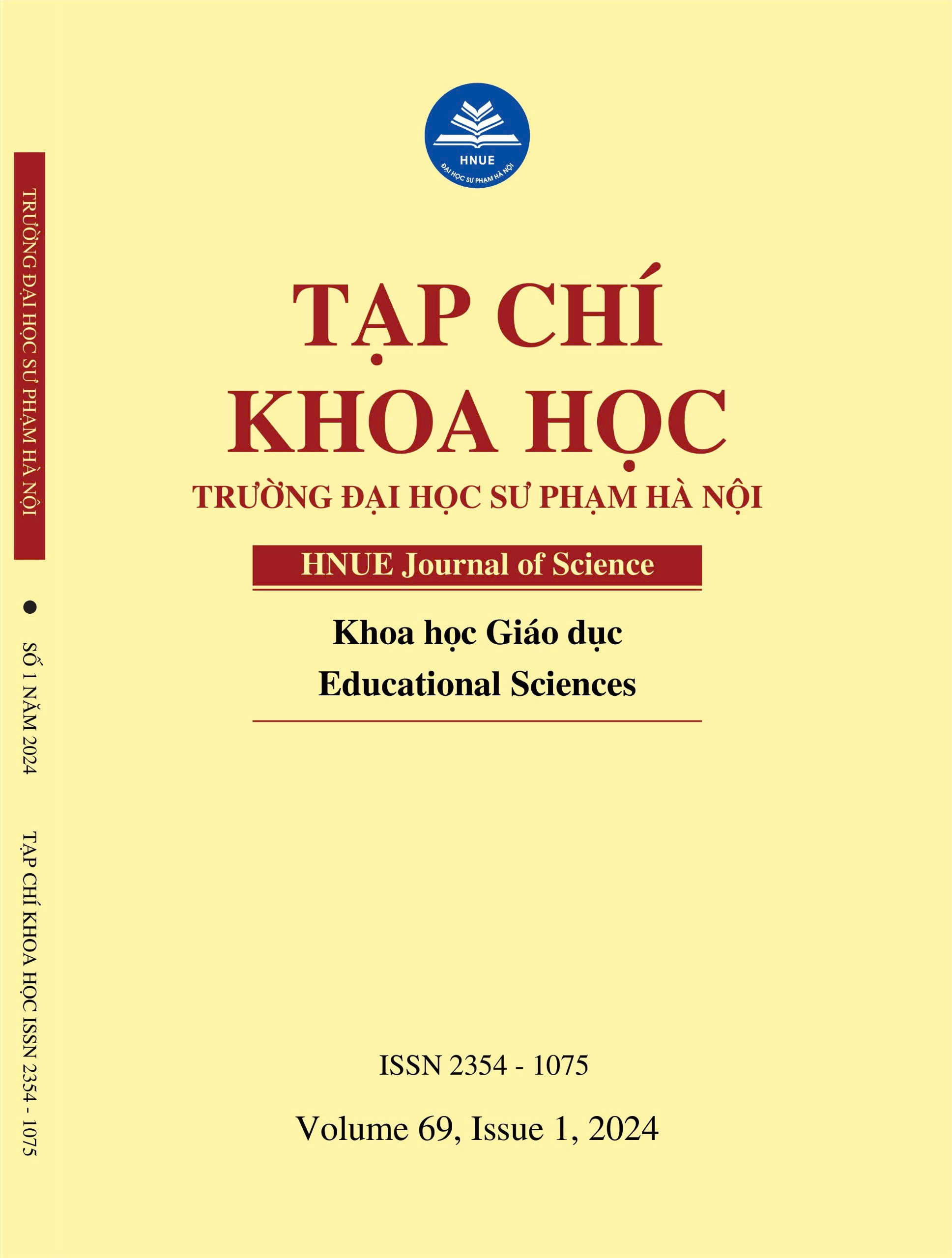ADAPTATION THE CYBERBULLYING VICTIMIZATION SCALE FOR ADOLESCENTS
DOI:
https://doi.org/10.18173/2354-1075.2024-0006Keywords:
cyberbullying, victimization, adolescentsAbstract
The study aimed to adapt the cyberbullying victimization scale for adolescents. The research sample included 102 students in Binh Duong province. Research results showed that the cyberbullying victimization scale for adolescents includes eight items (a single factor) with good Cronbach’s alpha reliability and construct validity (χ2/df = 1,440; CFI = 0,975; GFI = 0,936; RMSEA = 0,066 và PCLOSE = 0,290). This study determined that 58.8% of students were victims of cyberbullying. This study contributed to enriching measurement tools for cyberbullying in Vietnam.
Downloads
References
[1] Q. T. Le, (2020). “A Study of the Core Relationship between Cyber-Bullying and Coping of High-School Pupils in Vietnam,” Int. J. Innov., vol. 11, no. 3, p. 483–500.
[2] HTT Quỳnh and HT Hải, (2023). “Đánh giá một số chương trình phòng ngừa bắt nạt học đường cho học sinh trung học cơ sở trên thế giới và bài học kinh nghiệm cho Việt Nam,” Tạp chí Tâm lí học, vol. 3, no. 288, p. 16–31.
[3] M. Campbell and S. Bauman, (2018). “Cyberbullying: Definition, consequences, prevalence,” in Reducing Cyberbullying in Schools, Elsevier, p. 3–16. doi: 10.1016/B978-0-12-811423-0.00001-8.
[4] N. Auemaneekul, A. Powwattana, E. Kiatsiri, and N. Thananowan, (2019). “Investigating the mechanisms of theory of planned behavior on Cyberbullying among Thai adolescents,” J. Heal. Res., vol. 34, no. 1, p. 42–55, Nov., doi: 10.1108/JHR-02-2019-0033.
[5] M. J. Marret and W. Y. Choo, “Factors associated with online victimisation among Malaysian adolescents who use social networking sites: a cross-sectional study,” BMJ Open, vol. 7, no. 6, p. e014959, Jun. 2017, doi: 10.1136/bmjopen-2016-014959.
[6] D. Nazriani and S. Zahreni, (2017). “Adolescent Cyberbullying in Indonesia: Differentiation between Bullies and Victim,” Adv. Soc. Sci. Educ. Humanit. Res., vol. 81, p. 505–508.
[7] J. Z. N. Khong, Y. R. Tan, J. M. Elliott, D. S. S. Fung, A. Sourander, and S. H. Ong, (2020). “Traditional Victims and Cybervictims: Prevalence, Overlap, and Association with Mental Health Among Adolescents in Singapore,” School Ment. Health, vol. 12, no. 1, p. 145–155, Mar., doi: 10.1007/s12310-019-09337-x.
[8] C. V. Tran, B. Weiss, and N. P. H. Nguyen, (2022). “Academic achievement, and cyber-bullying and cyber-victimization among middle- and high-school students in Vietnam,” Int. J. Sch. Educ. Psychol., vol. 10, no. 1, p. 118–127, Jan., doi: 10.1080/21683603.2020.1837700.
[9] H. T. H. Le, H. T. Nguyen, M. A. Campbell, M. L. Gatton, N. T. Tran, and M. P. Dunne, (2017). “Longitudinal associations between bullying and mental health among adolescents in Vietnam,” Int. J. Public Health, vol. 62, no. S1, p. 51–61, Feb.
[10] HTT Quỳnh, (2023). “Thực trạng bị bắt nạt qua mạng ở học sinh trung học phổ thông tại tỉnh Thừa Thiên Huế và mối quan hệ với các vấn đề sức khỏe tâm thần,” Tạp chí Tâm lí học, vol. 7, tr.1-12.
[11] T. T. Thai, M. H. T. Duong, D. K. Vo, N. T. T. Dang, Q. N. H. Huynh, and H. G. N. Tran, (2022). “Cyber-victimization and its association with depression among Vietnamese adolescents,” PeerJ, vol. 10, p. e12907, Feb., doi: 10.7717/peerj.12907.
[12] J. W. Patchin and S. Hinduja, (2010). “Cyberbullying and Self-Esteem,” J. Sch. Health, vol. 80, no. 12, p. 614–621, Dec., doi: 10.1111/j.1746-1561.2010.00548.x.
[13] T. T. B. Phạm and Q. A. Trần, (2016). “Bắt nạt qua mạng ở học sinh trung học phổ thông và một số yếu tố liên quan,” Tạp chí Nghiên cứu Y học, vol. 104, no. 6, p. 0–6,.
[14] T. T. Q. Ho, C. Li, and C. Gu, (2020). “Cyberbullying victimization and depressive symptoms in Vietnamese university students: Examining social support as a mediator,” Int. J. Law, Crime Justice, vol. 63, p. 100422, Dec., doi: 10.1016/j.ijlcj.2020.100422.
[15] LTH Hà, NT Hương, TQ Tiến, M. Campbell, and M. Dunne, (2016). “Giá trị và độ tin cậy của thang đo bị bắt nạt học đường và qua mạng: Kết quả nghiên cứu với học sinh đô thị Hà Nội và Hải Dương,” Tạp chí Y tế Công cộng, vol. 40, p. 198–204.
[16] B. M. Tynes, C. A. Rose, and D. R. Williams, (2010). “The Development and Validation of the Online Victimization Scale for Adolescents,” Cyberpsychology J. Psychosoc. Res. Cybersp., vol. 4, no. 2, p. 1–15.
[17] S. Matsuzaka, L. R. Avery, A. G. Stanton, and S. Espinel, (2022). “Online Victimization, Womanism, and Body Esteem among Young Black Women: A Structural Equation Modeling Approach,” Sex Roles, vol. 86, no. 11–12, p. 681–694, Jun., doi: 10.1007/s11199-022-01296-z.
[18] J. Hair, W. Black, B. Babin, and R. Anderson, (2010). “Multivariate Data Analysis: A Global Perspective,” in Multivariate Data Analysis: A Global Perspective, Boston, MA: Pearson Education.
[19] R. C. MacCallum and L. R. Tucker, (1991). “Representing sources of error in the common-factor model: Implications for theory and practice,” Psychol. Bull., vol. 109, no. 3, p. 502–511.
[20] H Trọng and CNM Ngọc, (2008). Phân tích dữ liệu nghiên cứu với SPSS. NXB Hồng Đức.
[21] L. Hu and P. M. Bentler, (1999). “Cutoff criteria for fit indexes in covariance structure analysis: Conventional criteria versus new alternatives,” Struct. Equ. Model. A Multidiscip. J., vol. 6, no. 1, p. 1–55, Jan., doi: 10.1080/10705519909540118.







